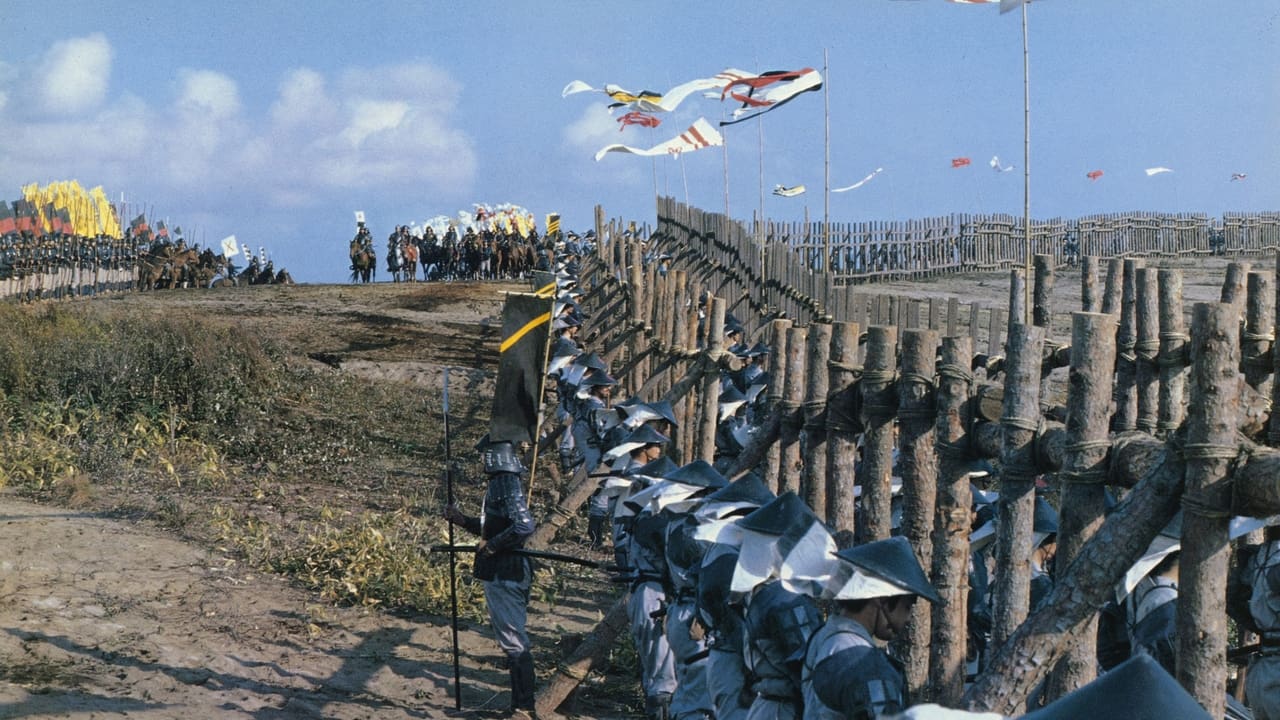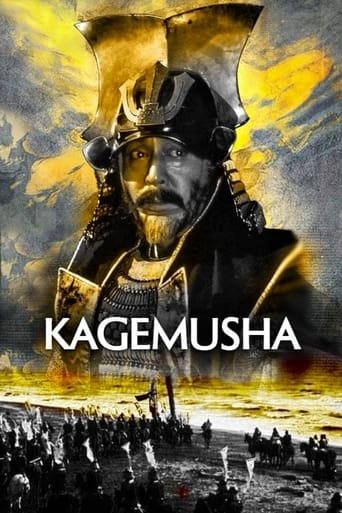

This is Akira Kurosawa's penultimate historical epic made before his last such film, RAN, in 1985. Kurosawa is best known for his string of successful samurai flicks made during the 1950s – the likes of SEVEN SAMURAI, THRONE OF BLOOD, and HIDDEN FORTRESS which have wowed critics and audiences alike for the last half century. KAGEMUSHA, THE SHADOW WARRIOR is a film that sometimes recaptures those glory days but for the most part is a lesser cousin to those classic works. Where films like SEVEN SAMURAI were epic in every sense of the word, the only thing epic about KAGEMUSHA is the running time, which is seriously overlong. This means that there are quite a few slow-paced scenes which add exposition, detail, and character so only the most patient viewers need apply.Yet this isn't the biggest problem with this flawed film. The major issue is the budget, which ran out before production was complete, meaning that George Lucas came in to supply funding when Toho lucked out. In the end, this provides Kurosawa with the biggest joke of all: he's made a war film without any battle scenes, except he tricks us into thinking he has. He shoots a major incident during the night, relying on some excellent sound effects to recreate the noise and feel of warfare; my favourite trick is the use of a flickering red and blue back screen to simulate the burning of a castle. Even at the climax, we only hear and then see the aftermath of a huge, decisive battle.The good news is that these things aren't too much of a problem, because at heart KAGEMUSHA is a character piece, all about the guy who pretends to be Shingen. Tatsuya Nakadai takes the duel role of warlord and stand-in, and he's frankly excellent; the finest element of the film. He crafts a believable character, a man living his life as a lie, and his development from a petty thief to a man who really believes that he's Shingen himself is spellbinding. It helps that he's supported by a great cast, all of whom are adept at the official Japanese 'stony face' stance. Kurosawa's is a film of small, telling details and the fact that the whole thing is based on a true story makes what happens even more amazing. A mature, intelligent work of film.
... View MoreThis movie takes its place in feudal Japan during the 16th century in which certain warlords are fighting amongst themselves to attain total supremacy. As luck would have it, a thief by the name of "Kagemusha" (Tatsuya Nakadai) just happens to bear an alarming resemblance to one of these warlords named "Shingen Takeda" (also Tatsuya Nakadai) and this strange coincidence is immediately seized upon by Shingen for its practical applications. In essence, this gives Shingen a perfect double in which to confuse his enemies. At least, that was his original intent. Unfortunately, Shingen is shot not long afterward and rather than allow his kingdom to totally collapse he convinces his brother keep his impending death a secret for 3 years to give his generals some time to adjust to the situation. This means employing Kagemusha to his fullest extent. And even then it might not be enough. Now rather than reveal any more I will just say that this was a magnificent film which incorporated stunning visual effects to achieve an incredible film experience. An excellent movie.
... View MoreAnother samurai epic by the master of the genre Akira Kurosawa; which, I find to be a mostly fulfilling attempt.The film follows the life of a peasant thief named Kagemusha who happens to look like the warlord of the Takeda clan Shingen. He is found by Shingen's brother Nobukado where he is trained to be Shingen's third body double in case of emergency. Of course this fate is realized when a assassin's sniper rifle finds Lord Shingen during a battle. Shengin remains alive for a while to let his men know that he wanted to be alive three more years for it was his goal to capture Kyoto and if he should die he would want it kept a secret so his clan would not go into disarray. Unfortunately Shingen passes from his wound and it is decided by the his cabinet that Kagemusha must pretend to be Shingen for three years (this secret is even kept from Shingen's family).It is important for his double to keep his persona for if his enemies were to suspect lord Shigen dead then they wouldn't have fear of attacking, but knowing that he may still be living made them second guess their attacks and kept the clan safe. It also helped to protect the clan from itself for the warlords replacement was a mere boy and a son who is blanketed by his father's shadow who is trying desperately to find himself(which is a major theme of the film).Their are many themes in this film of which to talk about but the most important one is finding ones self. Shingen's son Katsuyori is very lost even before his father's death. His son is the next in line to become leader of the clan ,which; brings him much embarrassment for he has felt his father was not fairing of him making him want to distance himself from Shingen's lore. These feelings later in the film become cataclysmic as certain discoveries are made. Kagemusha himself is lost between loyalty to his master and still knowing himself ,which; he is not able to be under the circumstances. There is a point in the film when he takes the persona too far it has dire consequences, but it puts things back in perspective for him where he finds what he truly loves.The first two hours of the film are phenomenal, but the battle sequences once began got a little confusing at times especially a scene at night where you're not sure who the friends or enemies are. I didn't fully understand the sequence until it had ended and I felt it was the weakest part of the film lasting I believe between 15-20 minutes. I wasn't a big fan of the ending also it felt a little rushed to me for Kurosawa ,which; I find to be out of character for him, but I will say the films final shot was magnificent.To Conclude I would say that despite the weak final act the rest of the film was very entertaining with an interesting premise and strong characters. If you are a Kurosawa fan you will love it as I did, however; it is definitely not in the category of Seven Samurai, or Roshomon. Visually astounding(the nightmare sequence was my favorite) at times and maybe a little confusing at others in the end it is to good of a film to pass up on even if it has its flaws.
... View MoreAkira Kurosawa, acclaimed Japanese film writer and director, is probably best known in the west via his influence on many notable new wave era filmmakers. Here two of those Kurosawa acolytes, George Lucas and Francis Ford Coppola, repaid the debt as it were by helping to finance the Japanese veteran's most ambitious and stupendous epic yet. In spite of its grandeur, Kurosawa would later dismiss Kagemusha as a mere "dress rehearsal" for Ran, his even vaster epic of 1985. But when watching this earlier picture's awesome pageantry and historical re-enactment, one's likely response is "some rehearsal!" Kagemusha takes Kurosawa back to his biggest hits of the 1950s, being set in war-torn feudal Japan. However the focus is very different, moving away from the peasants, bandits and disgraced warriors as protagonists and small-scale human relations as his themes, now looking at the machinations of the highest echelon of that society, with an often cold and distant eye. Since his 1971 suicide attempt Kurosawa seemed to become more cynical and detached from human affairs, not just as a writer but also in his technical style as a director. Kagemusha contains very few close-ups, with even key dialogue scenes filmed with vast gaps between camera and actors, and objective god-shots for the busier scenes.And yet there are similarities here with Kurosawa's much earlier pictures, especially in the director's aesthetic use of movement and stillness within the frame. Check out the scene in which the soldiers hear an enemy playing a flute from across the lines. The men are completely motionless, and the only movement is a flickering fire in the background and the occasional twitch of a flag in the breeze. It makes for a considerably mystical moment. But this approach has a function beyond the aesthetic. The opening scene, filmed all in one shot, shows Lord Shingen, the impersonator (both played by Tatsuya Nakadai) and Nobukado (Tsotomu Yamazaki) all sat in the throne room. The impersonator does not speak until near the end of the scene, but our eyes are drawn to him because of his movements – the occasional change in posture or flash of the eyes – and the comparative stillness of the other two. This long unbroken take means the room, with its great floral crest, is imposed into our minds, and resonates later on when we see Nakadai in the same room, now instated as the lord.And despite the distances between camera and cast, the colourful costumes against plain backdrops really puts an emphasis on the people in Kagemusha, allowing them to express themselves through body language more than facial expression. Lead man Tatsuya Nakadai is really adept at this, putting so much feeling into a shrug of his shoulders or a turn of his head. When you see, in this picture, the complex vocal arrangements and stylised movements of the Noh troupe, or the drummers who are able to make two strikes a fraction of a beat apart, you see examples of precise co-ordination in many formal rituals of Japanese culture. Nakadai has that same precision and control over his body, and turns them towards both theatrical gesture and realist reaction. And in those one or two cases in which we get to see his face close-up we see his talent there too, an ability to display a real look of emotional injury.So far there is very little I have said about Kagemusha that one could not also say about the later epic Ran, with the exception of Ran being a little an even bigger production and a little more stylised. So perhaps Kurosawa was right to think of the earlier picture as being a lesser forerunner to the later one. And yet, Kagemusha has the edge over Ran in one aspect. Whereas Ran is a totally dismal and inhumane affair, Kagemusha retains the heart and humanism of Kurosawa's older pictures. Composer Shinichiro Ikebe provides a rousing orchestral score, shot through with a touch of melancholy, and this beautifully matches the tone of the whole piece. It may lack the hopeful message of Seven Samurai or Rashomon, but it has the same warm regard for its characters that, even with a more objective eye, Kurosawa allows us to share in.
... View More